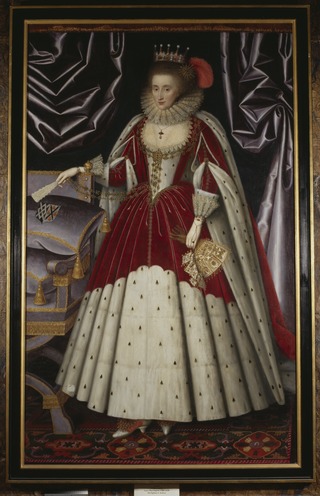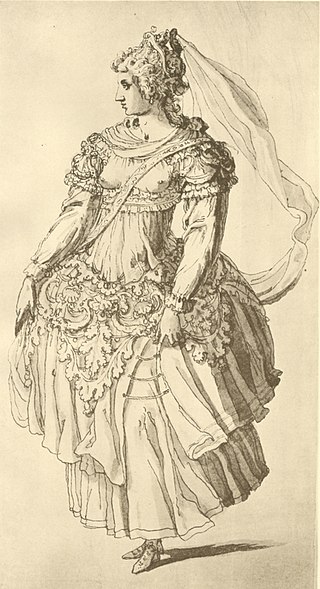
The masque was a form of festive courtly entertainment that flourished in 16th- and early 17th-century Europe, though it was developed earlier in Italy, in forms including the intermedio. A masque involved music, dancing, singing and acting, within an elaborate stage design, in which the architectural framing and costumes might be designed by a renowned architect, to present a deferential allegory flattering to the patron. Professional actors and musicians were hired for the speaking and singing parts. Masquers who did not speak or sing were often courtiers: the English queen Anne of Denmark frequently danced with her ladies in masques between 1603 and 1611, and Henry VIII and Charles I of England performed in the masques at their courts. In the tradition of masque, Louis XIV of France danced in ballets at Versailles with music by Jean-Baptiste Lully.

Frances Carr, Countess of Somerset, was an English noblewoman who was the central figure in a famous scandal and murder during the reign of King James I. She was found guilty but spared execution, and was eventually pardoned by the King and released from the Tower of London in early 1622.

The Masque of Blackness was an early Jacobean era masque, first performed at the Stuart Court in the Banqueting Hall of Whitehall Palace on Twelfth Night, 6 January 1605. It was written by Ben Jonson at the request of Anne of Denmark, the queen consort of King James I, who wished the masquers to be disguised as Africans. Anne was one of the performers in the masque along with her court ladies, all of whom appeared in blackface makeup. In a ceremony earlier on the day, Prince Charles, Anne's second son was given the title of Duke of York.
The Masque of Queens, Celebrated From the House of Fame is one of the earlier works in the series of masques that Ben Jonson composed for the House of Stuart in the early 17th century. Performed at Whitehall Palace on 2 February 1609, it marks a notable development in the masque form, in that Jonson defines and elaborates the anti-masque for the first time in its pages.

Lucy Russell, Countess of Bedford was a major aristocratic patron of the arts and literature in the Elizabethan and Jacobean eras, the primary non-royal performer in contemporary court masques, a letter-writer, and a poet. She was an adventurer (shareholder) in the Somers Isles Company, investing in Bermuda, where Harrington Sound is named after her.
Love's Triumph Through Callipolis was the first masque performed at the Stuart Court during the reign of King Charles I, and the first in which a reigning monarch appeared. The work was written by Ben Jonson, with costumes, sets, and stage effects designed by Inigo Jones, and music by Nicholas Lanier. This play Also played in Greece national theatre in 1979 together with the Johnsons masques Oberon, the faery prince and News from the new world discovered in the moon.
Chloridia: Rites to Chloris and Her Nymphs was the final masque that Ben Jonson wrote for the Stuart Court. It was performed at Shrovetide, 22 February 1631, with costumes, sets and stage effects designed by Inigo Jones.
Oberon, the Faery Prince was a masque written by Ben Jonson, with costumes, sets and stage effects designed by Inigo Jones, and music by Alfonso Ferrabosco and Robert Johnson. Oberon saw the introduction to English Renaissance theatre of scenic techniques that became standard for dramatic productions through the coming centuries.

The Hue and Cry After Cupid, or A Hue and Cry After Cupid, also Lord Haddington's Masque or The Masque at Lord Haddington's Marriage, or even The Masque With the Nuptial Songs at the Lord Viscount Haddington's Marriage at Court, was a masque performed on Shrove Tuesday night, 9 February 1608, in the Banqueting House at Whitehall Palace. The work was written by Ben Jonson, with costumes, sets, and stage effects designed by Inigo Jones, and with music by Alfonso Ferrabosco – the team of creators responsible for previous and subsequent masques for the Stuart Court.
John Ramsay, 1st Earl of Holderness, known as Sir John Ramsay between 1600 and 1606, and as the Viscount of Haddington between 1606 and 1621, was an important Scottish aristocrat of the Jacobean era, best known in history as the first favourite of James I when he became king of England as well as Scotland in 1603.
The Golden Age Restored was a Jacobean era masque, written by Ben Jonson and designed by Inigo Jones; it was performed on 1 January and 6 January 1616, almost certainly at Whitehall Palace.
Mercury Vindicated from the Alchemists at Court is a Jacobean-era masque, written by Ben Jonson and designed by Inigo Jones. It was performed at Whitehall Palace on Twelfth Night, 6 January 1615. King James I liked it so much that he ordered a repeat performance the following Sunday, 8 January.
The Speeches at Prince Henry's Barriers, sometimes called The Lady of the Lake, is a masque or entertainment written by Ben Jonson in honour of Henry Frederick, Prince of Wales, the son and heir of King James I of England. The speeches were performed on 6 January 1610 in conjunction with the ceremony known as Prince Henry's Barriers.
Lord Hay's Masque was an early Jacobean era masque, written by Thomas Campion, with costumes, sets and stage effects designed by Inigo Jones. The masque was performed on Twelfth Night, 6 January 1607, in the Great Hall of Whitehall Palace. It was the premier event at the Stuart Court for the 1606-7 Christmas holiday season.

The Vision of the Twelve Goddesses was an early Jacobean-era masque, written by Samuel Daniel and performed in the Great Hall of Hampton Court Palace on the evening of Sunday, 8 January 1604. One of the earliest of the Stuart Court masques, staged when the new dynasty had been in power less than a year and was closely engaged in peace negotiations with Spain, The Vision of the Twelve Goddesses stood as a precedent and a pattern for the many masques that followed during the next four decades.
An antimasque is a comic or grotesque dance presented before or between the acts of a masque, a type of dramatic composition. The antimasque is a spectacle of disorder which usually starts or precedes the masque itself and was played by professional actors while members of the court primarily performed the roles of the masque. It is characterized by impropriety and is transformed by the masque into goodness, propriety, and order, typically by the King's presence alone. It was also contrasted with the masque by the use of the lower class as characters. This then was supposed to harmonize with the king and the higher class. In later years, the antimasque developed into a farce or pantomime. The concept of the antemasque, or anti-masque, was conceived by Ben Jonson. Masques originally usually had one antemasque before the main masque, but later it became common to have several antemasques preceding the main masque.

Sir Robert Mansell (1573–1656) was an admiral of the English Royal Navy and a Member of Parliament (MP), mostly for Welsh constituencies. His name was sometimes given as Mansfield and Maunsell.
Elizabeth Howard, Lady Knollys, courtier to Anne of Denmark.
Dorothy Hastings was a courtier to Elizabeth I of England and Anne of Denmark

Christopher Shawe or Shaw was an English embroiderer and textile artist who worked on masque costume for Anne of Denmark. He was a member of the Worshipful Company of Broderers.








